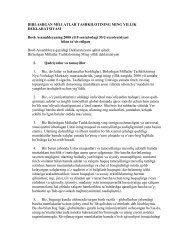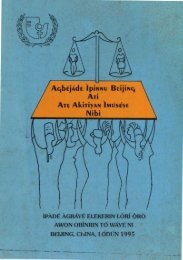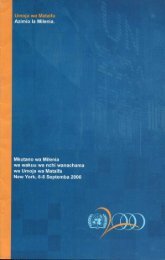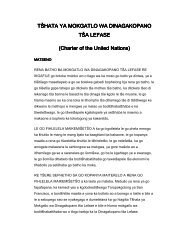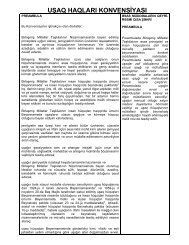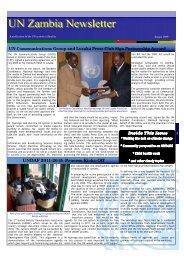Download Newsletter - United Nations Information Centres
Download Newsletter - United Nations Information Centres
Download Newsletter - United Nations Information Centres
You also want an ePaper? Increase the reach of your titles
YUMPU automatically turns print PDFs into web optimized ePapers that Google loves.
VOLUME 37 AUGUST, 2011<br />
Nepal’s links with Silk<br />
Roads may be<br />
officially recognized<br />
KATHMANDU, 29 August —<br />
Nepal has played a crucial role in<br />
trade between China and India in<br />
the past and some of the routes<br />
crossing the country may have<br />
been branches of the famous Silk<br />
Roads, the 3,000 year-old-plus<br />
network of interlinking trade routes<br />
across the Afro-Eurasian landmass.<br />
Should Nepal‘s link to the Silk<br />
Roads be confirmed, the country<br />
could participate in a serial<br />
nomination of the Silk Roads onto<br />
UNESCO‘s World Heritage List,<br />
including a series of sites in several<br />
countries in the region.<br />
But a prerequisite for the country‘s<br />
possible participation in a serial<br />
nomination is thorough research to<br />
identify the routes through Nepal<br />
and the archaeological vestiges that<br />
prove their existence, said World<br />
Heritage Adviser Susan Denyer,<br />
from the International Council for<br />
Monuments and Sites (ICOMOS),<br />
at a UNESCO organized meeting in<br />
Kathmandu last week.<br />
The meeting that was opened on 25<br />
July by Khagendra Prasad Prasai,<br />
Minister of Federal Affairs,<br />
Constituent Assembly,<br />
Parliamentary Affairs and Culture,<br />
UN <strong>Information</strong> Centre Kathmandu<br />
was organized to explain the<br />
process of the serial nomination of<br />
the Silk roads, in which several<br />
countries, including China and<br />
India, are already strongly engaged,<br />
to the national stakeholders.<br />
Meeting participants said that Nepal<br />
has significant and remarkably<br />
intact archaeological features,<br />
essentially along three main routes,<br />
which most probably testify to<br />
Nepal‘s integration, exchange and<br />
dialogue with the main Silk Roads<br />
originating from Xi‘an in China.<br />
However, there is a need for more<br />
detailed analysis of the routes<br />
within Nepal to identify their links<br />
with the main Silk Roads and thus<br />
their potential as possible<br />
―corridors‖ for nomination‖.<br />
The Department of Archaeology will<br />
now engage in more detailed<br />
research in order to establish<br />
profiles groups of sites or individual<br />
sites along the three routes with a<br />
view to explore whether they reflect<br />
a specific period of history, power<br />
and patronage system that would<br />
give accounts on the organization<br />
of the flourishing trade and<br />
protection of the routes within<br />
Nepal.<br />
UN n e w s l e t t e r<br />
N e p a l<br />
Susan Denyer, ICOMOS Advisor<br />
explaining Nepalese authorities about the<br />
concept and process of the Silk Roads<br />
nomination project.<br />
Photo: UNESCO<br />
The result of these investigations<br />
will be discussed at a workshop<br />
later this year that may decide on<br />
the preparation of detailed<br />
descriptions on one or more nodal<br />
sites for the tentative list of Silk<br />
Roads.<br />
Experts believe that sites in<br />
Mustang, some of which are<br />
already on the Tentative List, and<br />
other sites elsewhere, yield<br />
outstanding value, not only on their<br />
own, but also for the Silk Roads in<br />
their entirety.<br />
Within the framework of UNESCO‘s<br />
assistance for the Silk Roads serial<br />
nomination project, which is<br />
financed through the Norway Funds<br />
-in-trust, Nepal attended the first<br />
and second meetings of the<br />
coordinating committee on the<br />
serial World Heritage nomination of<br />
the Silk Roads held respectively in<br />
Xi‘an, China in 2009; and in<br />
Ashgabat, Turkmenistan in 2011.<br />
Nepal indicated that it would follow<br />
up the Ashgabat Agreement in<br />
advancing collaboration among<br />
Asian State Parties to recognize the<br />
history of their linked cultural<br />
development and it is in the process<br />
of designating a national project<br />
manager, as agreed during the<br />
Ashgabat meeting.<br />
www.un.org.np, kathmandu.unic.org<br />
UNITED NATIONS IN NEPAL<br />
13



